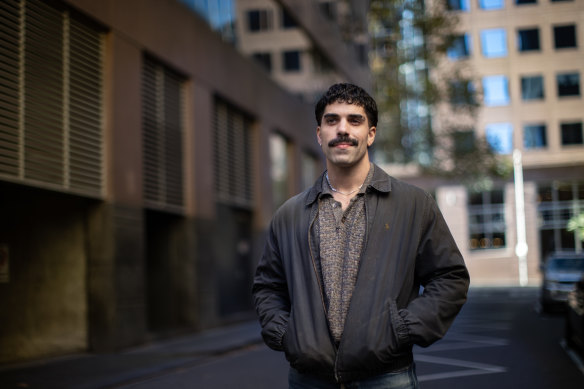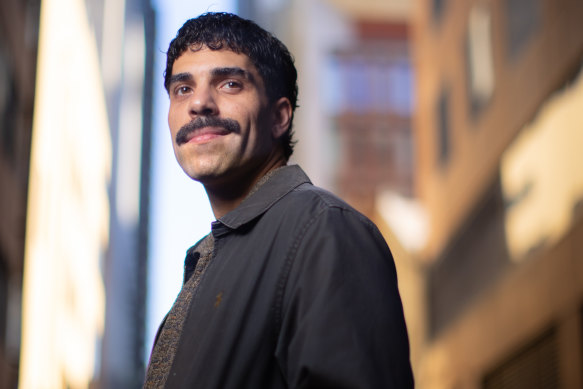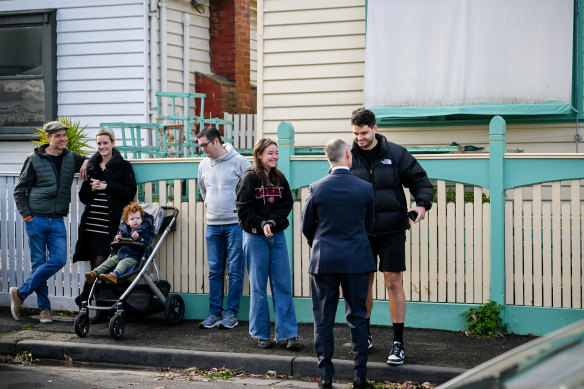This was published 6 months ago
The Melbourne suburbs where you should have bought a house
By Jim Malo
Nearly 100 suburbs have fallen out of reach for home buyers over the past two years, as rising interest rates push the cost of buying a home to unaffordable levels.
Ninety-five markets that were within reach two years ago are no longer affordable to couples both earning the average income, including Brunswick, Oakleigh and Yarraville, CoreLogic analysis reveals.

Nik Angelakis says he has been priced out of his preferred suburbs in the inner north. Credit: Simon Schluter
More had fallen out of reach for couples earning 1½ times the average income — 174 markets in total, including Altona North, Footscray and Sunshine.
For singles, 142 markets became unattainable over the past two years, and just 19 are considered affordable in 2024.
CoreLogic head of Australian research Eliza Owen said about 28 per cent of the city was unaffordable for households earning double the average income.
“At a high level, the list implies both adults in the household need to be working full-time and even then, it’s not enough to get you into a lot of these markets with a 20 per cent deposit,” Owen said. “It’s a good illustration of home ownership being unattainable with hard work and savings alone.
“When it comes to single-dom, it’s even worse. For singles, there are just 19 markets that are accessible now, compared to 161 two years ago before interest rates started to rise.”
In 2022, the Reserve Bank began hiking interest rates at the steepest pace in decades, and brought them from a record low of 0.1 per cent to 4.35 per cent now. Buyers’ borrowing capacity has been slashed as a result.
The analysis used estimated borrowing capacities from Canstar, based on the average annual salary of $98,212. Suburb house and unit medians below estimated borrowing capacity were considered affordable.
Estimated budgets at auction are now $1,075,000 for a dual-income couple, $756,250 for a household on 1½ times the average income, and $465,000 for a single.
The biggest drop in budget was in double-income households, with $485,000 wiped out since 2022. The analysis assumed buyers contributed a 20 per cent deposit, as much as $215,000 for higher-earning households. In practice, however, if someone had been trying to find a home to buy for two years, they might have a higher deposit saved and could spend more on a home.
Buyers with a smaller deposit may need to access the federal government’s Home Guarantee Scheme, which allows low-deposit purchases under income and purchase price caps, or pay lender’s mortgage insurance, which varies but can add about 3 per cent to the loan cost.
Dual-income couples would need to stump up $59,125 in stamp duty for the most expensive home they could afford; a couple with 1½ the average income would need to pay $40,445, and a single would pay $19,870, if they weren’t a first home buyer. Otherwise, it would be waived.
Mortgage repayments would be $2445 a month for a single, $3976 for a household on 1½ times the average income, and $5652 for a dual-income household.
First home buyer Nik Angelakis was trying to buy by himself, and was hoping to buy a house or property with a freehold title. A lawyer, he was able to get approval for a loan with a 10 per cent deposit and without lender’s mortgage insurance, but even then, he found he had few options.
“The first difficulty is finding any freehold houses in decent condition around the $700,000 to $800,000 price range. You won’t find anything,” he said. “I did inspect a property in Brunswick around a month ago, it was asking $880,000 – all the wood inside was rotting. Weatherboards that were completely eroded … I got the impression that was the type of property I’d have to accept if it was looking at my budget or just above it.”
Angelakis expanded his search to inner western suburbs, such as Footscray, in the hope of finding an affordable house.
Jas Stephens selling agent George Alexander said it was common to see buyers from the inner north looking to purchase in Footscray and West Footscray because of their affordability. More high-end areas like Seddon and Yarraville were becoming too expensive for young professionals looking for a bargain, he said.
“Yarraville and Seddon have just taken off, but they also have different kinds of houses,” Alexander said. “[A] lack of volume plus the recovery post-COVID has caused Yarraville and Seddon to spike a bit more.”
Alexander said prices in the west had risen to levels he felt were becoming unaffordable for locals in the area, despite perceptions in value from buyers elsewhere in the city.
“People still see it as cheap,” he said.“[But] I don’t know what kind of world we live in where you need $600,000-plus for a unit, $1 million for a house.”

Angelakis says inner-north houses in his price range are unliveable, and he is now looking in the inner west. Credit: Simon Schluter
Angelakis had help getting finance from brokerage Finspo whose chief executive, Angus Gilfillan, said he’d noticed buyers were taking longer to find the right home, and many first home buyers were making compromises.
“We’re finding the customers are staying in the approval in-principle period for longer,” he said. “For some people, location really is key, so they’ll look at sacrificing property type or size. Whereas others will sacrifice the location to get the home of their dreams.
“The affordability gap has become worse so the need to compromise has increased, particularly for first home buyers.”

Estimated budgets at auction are now $1,075,000 for a dual-income couple.Credit: Joe Armao
Though high interest rates had cut his borrowing power, Angelakis said he thought it would be more difficult to buy if they were lower.
“You’d have more demand in the market, which would mean it’s more of a seller’s market, and they’d be listing for higher because demand would meet it, but at the same time … I’m looking at properties on what I can afford now with the funds I’m able to borrow and just hoping rates stay at a manageable level.”